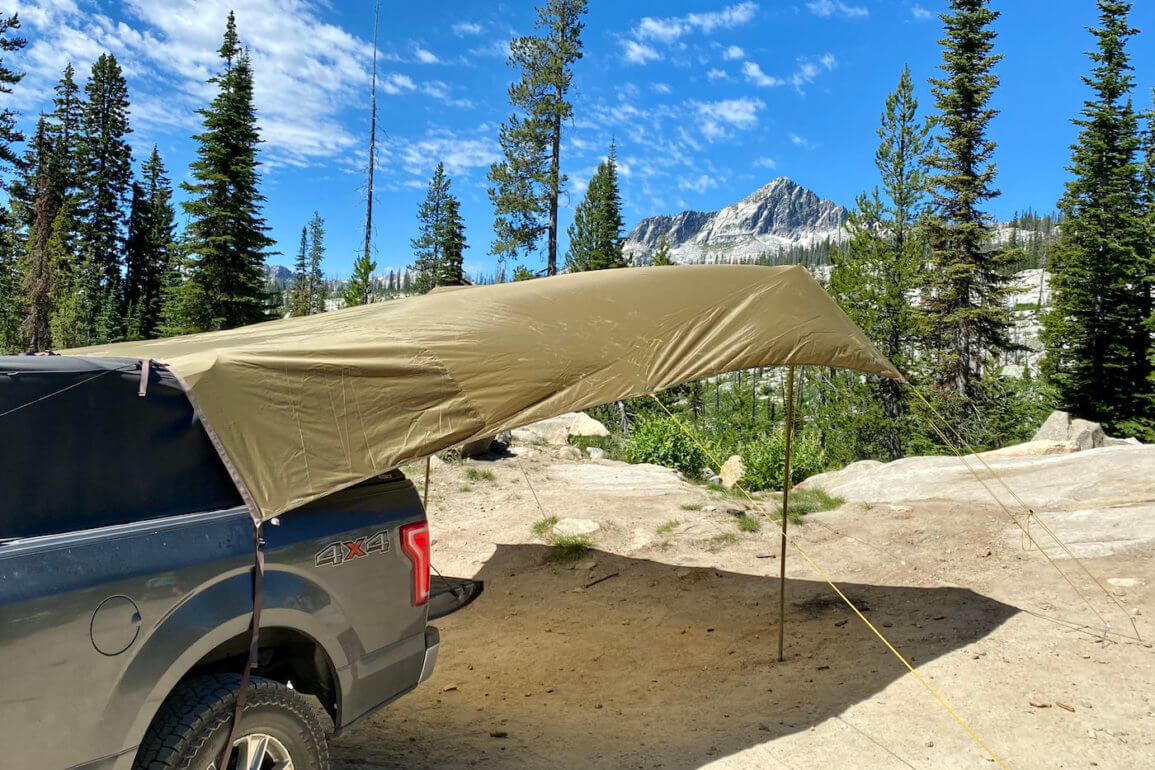The SJK Roadhouse Tarp is a large, versatile sun and rain shelter for overlanding, car camping, hunting, day-tripping and most any off-road adventure. While it’s designed primarily to attach to the rear of your vehicle, you can also pitch it to stand alone.
To get us a closer look, SJK sent Man Makes Fire a review unit. After setting it up and testing it in the Idaho backcountry, this is what we learned:
SJK Roadhouse Tarp Review
SJK makes camping, hunting, and overlanding outdoor gear, including backpacks, sleeping bags, tents, and overlanding gear. On the weekend I was out testing the Roadhouse Tarp, in fact, I saw two different Jeeps with SJK Overland Utility Bins strapped to their spare tires.
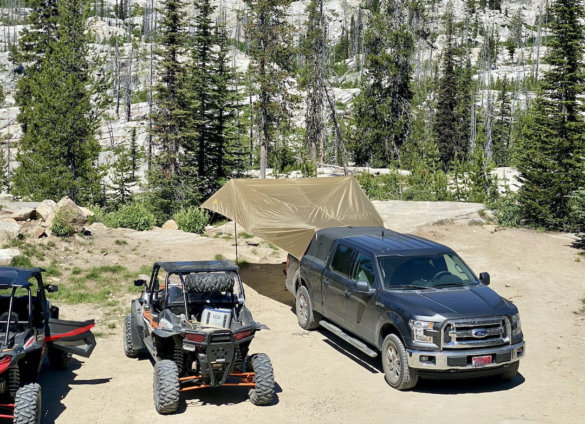
The SJK Roadhouse Tarp is a 3-in-1 tarp shelter with a built-in attachment system that connects best to Jeeps, SUVs, and pickups with canopies, toppers or cab-height rack systems. That basic idea is that you back into some awesome outdoor place to park where you can camp, hang out, eat, drink and stay out of the sun or rain.
If you’ve seen photos of the SJK Roadhouse Tarp, you already have the basic idea . . . but you likely want to know if it’s easy to set up, how well it works in sun, wind, and rain — and if the quality is good.
Size and Specifications

The shape of the tarp is basically an elongated trapezoid. The short side that is intended to attach to your vehicle is 103″ while the long side with the multiple pole supports is 192″. The length (that extends from the rear of your vehicle) is 160″.
If you set up the tarp with about three feet overlapping the top of your vehicle, you’re left with about 10′ of coverage extending off the back of your vehicle. The maximum distance from your vehicle would be about 13′.
The distance between the poles in the two-pole setup, when attached to a vehicle, is a little over 9′.
Specs:
Dimensions: 160″ x 103/192″
Peak Height: 96″
Weight: 12 lbs 6 oz
Packed Size: 25″ x 7″ x 7″
Fly Material: 68D Polyester w/1200mm waterproof rating
SJK also offers a screen house tent-like option that is similar to the Roadhouse Tarp. Aptly named the Roadhouse Screen Tarp, it is the same overall size and design as the Roadhouse Tarp but it also includes a built-in mesh screen that drops down to keep mosquitoes and pesky insects out. If you don’t need the screen, you can roll it up out of the way. If you spend a lot of time in buggy areas, the Roadhouse Screen Tarp might be your best choice.
How to Pitch the Roadhouse Tarp
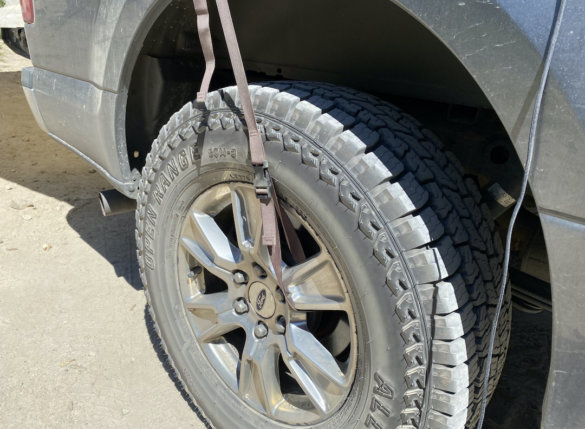
It’s possible to set up the Roadhouse Tarp by yourself in light wind. However, it’s far easier to set up with two people.
Ideally, you’ll read the setup instructions and set up the Roadhouse Tarp at home — but if you can set up a camping tent, you can set up the Roadhouse Tarp.
Start by finding the narrow end of the tarp with the built-in wheel connection straps. Pull the narrow end of the tarp over the top of your pickup topper, roof rack or Jeep/SUV. Attach the wheel straps by threading them through a spoke in the rear wheels. Of course, if you have something else on your vehicle to attach them to, such as a step or running boards, you could use something like that.
The top of the narrow end of the tarp has three small clip straps that attach easily to roof racks. They’re not technically necessary, but I suggest you use them because they help maintain the shape of the Roadhouse Tarp. In my case, I have a Fas-Top soft topper on my pickup and there is no built-in spot for those top straps. When I ran a piece of paracord around the front of the topper (see photo below) to use two of the straps, it made final setup tighter. I’ll likely replace the paracord with a long bungie cord.
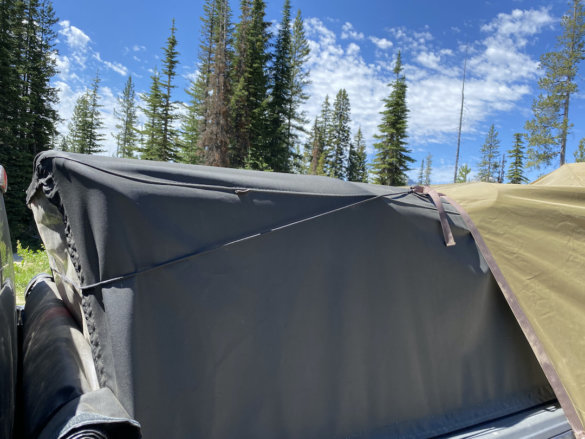
Next, pull the wide end of the tarp out from your vehicle. Assemble the included steel poles and place the top ends near the two farthest grommets. Now find and unravel the guy lines. There are four short guylines and two long guylines. The two long guy lines came with a loop knot tied into the middle and they are used for the poles.
The loop knots will go over the top pin on each pole, which will let you stake those poles out with two lines each for stability. Find spots 6-8 feet away from each of the pole grommets to form a triangle with the guylines. Pound the stakes in. Attach the loose ends of your guylines to the stakes then raise a pole, using the guylines to create and maintain tension. It will sloppily stand and stay in place if you do it right. This will give you time to raise the second pole. After both poles are up, you can adjust tension on the guylines or move stakes as needed to get the pitch well positioned.
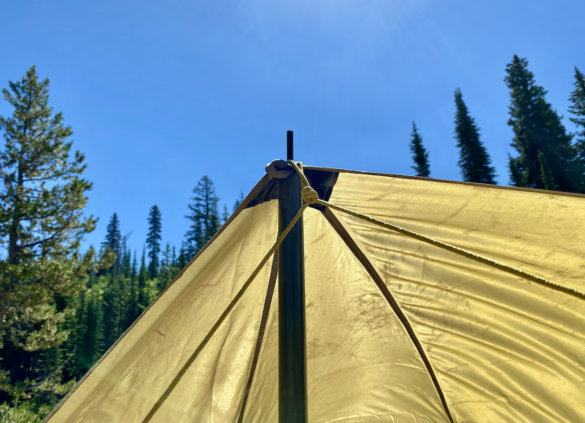
Use the remaining short guylines to attach to the obvious spots on the sides of the Roadhouse Tarp. In just a handful of minutes you can get a sweet, taught pitch.
If you have a partner who can hold a pole raised in the optimal spot as you pitch, everything will be easier and faster.
Is the Roadhouse Tarp Good in Wind?
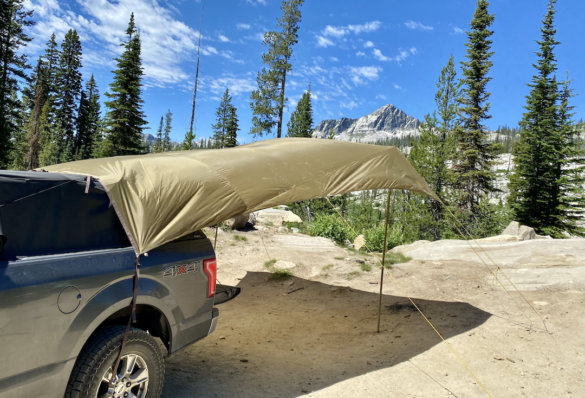
If you properly stake down the SJK Roadhouse Tarp and have good soil to hold your stakes, the Roadhouse Tarp should be able to withstand some gusty wind. The attachment points are reinforced, the guylines are stout, and the stakes are relatively big with a rounded hook designed to keep the guyline in place even if some slack enters the line.
When a bit of shade makes all the difference, the SJK Roadhouse Tarp is an outright winner.
Aside from your vehicle attachment points, SJK includes eight heavy-duty 10″ steel stakes that will connect to six points on the tarp (remember, the poles have a loop knot and two guylines, giving you one attachment point per pole). The result is surprisingly stable.
Overall, in my testing in moderate gusty mountain wind, the SJK held its shape very well. I was impressed and pleased.
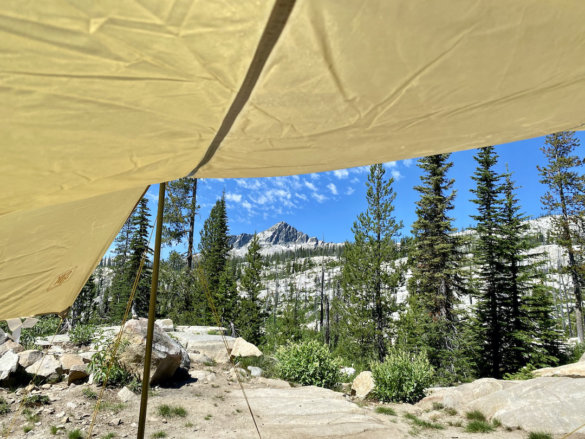
I haven’t yet had the Roadhouse Tarp out in a heavy rain, but it is waterproof and shed garden hose water easily enough during a quick backyard test. SJK reports that the 68D polyester material has a 1200MM waterproof rating. This isn’t a particularly high waterproof rating compared to rain jackets, but it’s sufficient for lightweight tarps that don’t experience extended contact pressure (like tent floors).
Quality
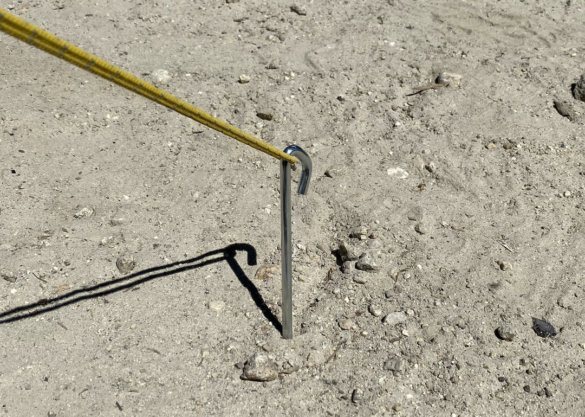
The overall quality is very good. It’s a lightweight tarp, similar to a typical camping tent rain fly in material and thickness. However, the guyline attachment points are strong with reinforced webbing. For the pole setup, the top pin on the poles goes through a reinforced metal grommet.
The poles are steel and 8′ tall. They’re far stouter than most cabin-style tent pole systems. The only drawback is that they’re not length adjustable. SJK connects the pieces together with stretchy cord (like tent poles) so they only connect to one length. However, you could remove the cord from inside the poles and use them without the connective stretch cord. That would give some additional pitch height options. Either way, I like the height and how airy it makes the tarp shelter feel when you’re underneath it.
I also appreciate the heavy-duty steel stakes. For overlanding in rocky soil, they should hold up well as you pound them in. They have a built-in curve at the end that helps keep the guylines connected, especially in wind that might introduce slack in the system.
Strap Use and Vehicle Protection
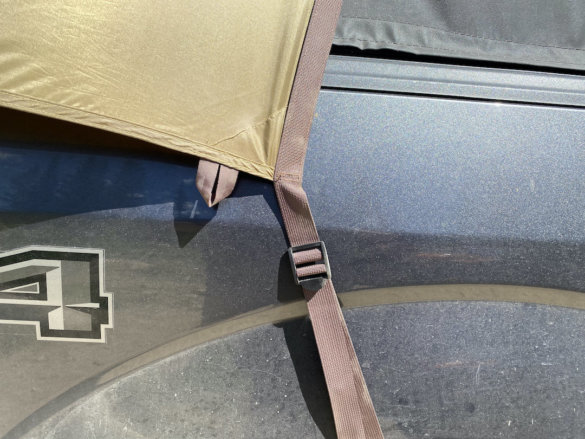
The biggest drawback that I see is the possibility that the vehicle anchor straps might rub or scratch your vehicle. Depending on your setup, it might not be an issue at all — but it could be. On our test vehicle, a Ford F-150 with a Fas-Top soft-top system installed, the wheel straps could touch the exterior sidewalls of the bed.
To solve this, I simply placed a section of foam pool noodle over the straps to create a cushion. In severe wind and dust, this foam may or may not keep my paint job pristine . . . but then I drive on narrow, brushy mountain roads and that takes a toll on my paint, too.
Shop the Roadhouse Tarp at SJK and get FREE Shipping on orders over $49!
Competitive Alternatives & Options
There are many vehicle tarps, awning and shade systems to choose from, and the key is finding the right shape and design for your vehicle and places you like to go. If you’re interested the SJK Roadhouse Tarp, you might also appreciate these competitive alternative options for your particular vehicle and setup needs:
Kelty Waypoint Car Tarp — The Kelty Waypoint Car Tarp design is very similar to the SJK Roadhouse Tarp. The most important difference is that it only comes with one pole. It pitches with a single-pole setup, attached to your vehicle. Like the Roadhouse Tarp, it uses a 68D polyester material. The biggest drawback is that it’s slightly smaller than the Roadhouse Tarp and isn’t easily set up away from a vehicle.
Kelty Sideroads Car Awning — Kelty also makes a dome tent-like shade system, the Sideroads Car Awning. We like the structure provided by the flexible pole system. We don’t like the smaller usable size compared to the larger Roadhouse Tarp. However, if you’re looking for easy side shade and a smaller amount of protection, the Sideroads Car Awning might be for you.
Yakima SlimShady 6.5′ Roof-Mounted Awning — The Yakima SlimShady is one of the more affordable rack- or roof-mounted awning systems available. It comes in three length options: 4.5′, 6.5′ and 8′. The primary benefit is that it’s always attached to your vehicle and is fast and easy to deploy. The biggest drawback is the smaller coverages. Also, mounting options will typically lead to placing it along the side of your vehicle and not off of the back like the SJK Roadhouse Tarp.
Coleman Instant Canopy — The primary benefit fo the Coleman Instant Canopy is that it’s mostly self-standing and tends to require less rigorous stake systems. The biggest drawback is it’s large and heavy packed size. We do, however, like that you can buy side wall accessories to help block the wind and add extra shade.
The Bottom Line
All-in-all, the SJK Roadhouse Tarp is a versatile, packable, and affordable vehicle-ready tarp system. When a bit of shade makes all the difference, the SJK Roadhouse Tarp is an outright winner — and it can give you a spot to cook or eat out of the rain. We appreciate how it packs down small but extends to a large and roomy size. Properly staked, we think it’s good in moderate wind. The single-pole system is fast and easy to set up, but we like the extra space in the two-pole setup best. Finally, if you need to move it away from the back of your vehicle to use a better spot outdoors, you can still set up the Roadhouse Tarp with the two included poles. So cool. Very highly recommended.
Get the Gear:

